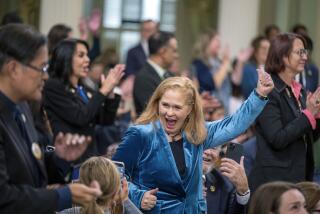Plan to Redraw Districts Passes
- Share via
SACRAMENTO — State lawmakers Thursday overwhelmingly approved and sent to Gov. Gray Davis bills designed to reduce competition at the ballot box and preserve the partisan status quo in the Legislature and California congressional delegation for the next 10 years.
In swift bursts of bipartisan cooperation, the usually fractious Assembly approved 58 to 10 a realignment of state Senate and congressional districts, while the Senate passed 40 to 0 a bill rewriting state Assembly districts.
Davis, who had insisted that the once-a-decade redrawing of political boundaries to reflect the 2000 census be a bipartisan effort, is expected to sign them quickly.
“We’ve been plugged into the process. We don’t see any major changes that the governor would ask for,” said spokesman Steve Maviglio.
The Assembly was almost giddy in approving its redistricting plan, SB 802, on a 65-8 vote, a proposal that drew praise and criticism from minority community activists.
But it was attacked by a few Assembly members as an unvarnished incumbent protection plan that needlessly split cities and ignored “communities of interest.”
But Assembly Speaker Bob Hertzberg (D-Sherman Oaks) defended the lower chamber lines as “sensitive” to minority community representation, and said they reflect nearly perfect populations of 423,396 per district.
“I understand it’s not a perfect plan,” Hertzberg said.
But he added that it will pass legal muster and was “done on a bipartisan basis in the most open way in the history of California.”
The proposal, however, attracted angry criticism.
Assemblyman Tim Leslie (R-Tahoe City), despite receiving a favorable GOP district himself, lambasted it as politically expedient at the expense of wider interests.
He said most districts were drawn so that “we won’t have to worry about elections for six, eight, 10 years because they are all preset. Everybody wins. . . . What happened to drawing lines for the people of the state rather than ourselves?”
Two Democrats from the Silicon Valley, Assemblywoman Elaine White Alquist of Santa Clara and Assemblyman Manny Diaz of San Jose, attacked the lower house program as a butcher block for splitting communities.
Alquist complained that nearly half of Santa Clara had been moved to another district.
Alquist also said she was shocked to learn last week--by chance--that her proposed district no longer included her home.
On the redistricting plan for the Senate and Congress, which had drawn criticism from minorities, Assemblyman Roderick Wright (D-Los Angeles) urged acceptance, telling colleagues that “this is about as good as it gets.”
In contrast to previous bloody redistricting fights stretching back at least 30 years, California Democrats and Republicans struck an unusual deal this time, aimed at protecting the partisan breakdown in the Legislature and House.
Under the agreement, minority Republicans guaranteed enough votes for a two-thirds majority on the redistricting bills so they would take effect immediately on Davis’ signature.
This would make them immune to a referendum challenge, which the GOP had threatened.
In exchange, Republican ranks would not be further reduced by the Democrats in charge of redistricting.
In the Assembly, Democrats outnumber Republicans 50 to 30; in the Senate, 26 to 14; and in the House, 32 to 20.
However, House Democrats are expected to gain one seat in Los Angeles County due to the creation of a heavily Latino 53rd District.
Outside the legislative chambers, Latino and Asian American political activists complained that their communities were entitled to a better shake.
“In the Assembly plan, we believe that the concerns for incumbency protection and having a bipartisan deal overrode giving a full opportunity to the Latino community in Los Angeles County and other ethnic communities as well,” said Amadis Velez of the Mexican American Legal Defense and Educational Fund.
He noted that at least one new Latino Assembly district is created in southeastern Los Angeles County by the Assembly proposal, but that the growth of the Hispanic population justifies a second such district.
“We were told that this could not be done without jeopardizing the bipartisan deal,” Velez said.
Kathay Feng of the Asian Pacific American Redistricting Coalition expressed disappointment that her communities’ efforts to lobby for a greater political voice did not pay off in a bigger way.
But she said that as a result of intense lobbying efforts, politicians now would have to take notice of Asian American and Pacific Islander constituencies at election time.
“Even if we did not represent a majority of any district, it was important that our communities were significantly [represented] within a particular district,” Feng said.
More to Read
Get the L.A. Times Politics newsletter
Deeply reported insights into legislation, politics and policy from Sacramento, Washington and beyond. In your inbox twice per week.
You may occasionally receive promotional content from the Los Angeles Times.










